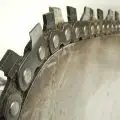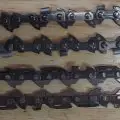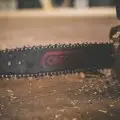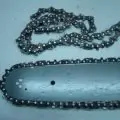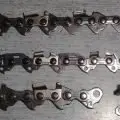Some tool parts are designed to wear out over time, and typically users learn how to replace them on their own. However, a flawless chain is necessary for a completely effective chainsaw, and you cannot simply swap out any chain for it. When replacing the chain, it’s difficult to know whether you can slap on any old chain in the hope that it’s universal or whether you need to find a specific one.
In this article, we answer whether chainsaws chains are universal, along with providing the additional aspects that must be taken into account.
Table of Contents
- Are Chainsaw Chains Universal?
- What Size Chain Is on My Chainsaw?
- 2 Tips on How to Find the Chain You Need
- Types of Chainsaw Chain
- FAQs (Frequently Asked Questions)
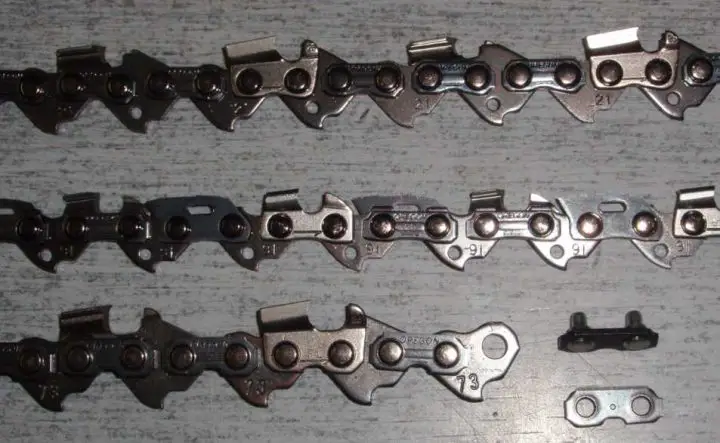
Are Chainsaw Chains Universal?
No, chains for chainsaws are not all-purpose.
They cannot be switched out. Some may be universal if several boxes are checked, but this is rarely the case. The following elements need to be taken into account when changing the chainsaw chain:
- Pitch
- Gauge
- Link count
- Types of chain
Together, these elements determine how long the chain is. These conditions must be met for a chain to fit. The details of these criteria can be found in your user manual. For some models, these are additionally noted as an engraving, a stamp, or a sticker on the side of the chainsaw bar.
Are Chainsaw Chains Brand-Specific?
Chainsaw chains are not strictly brand-specific, meaning that chains from one brand can often be used with chainsaws from another brand, as long as they match in size and specifications.
Chainsaw chains from different manufacturers may usually be used interchangeably because the pitch, gauge, and link count of the chain—rather than the chain’s manufacturer—determine how well it fits a chainsaw. If all the above factors are equal, then sure you can replace a Stihl chain with a Husqvarna chain and vice versa.
You shouldn’t use the chain on your chainsaw if any of these measurements don’t exactly match since it won’t fit. You can be considering shortening your chain if you have the improper size and don’t want to buy a new one. Therefore, you must check that the pitch, gauge, and link count match each time you look for a new chain (between the chain and chainsaw guide bar).
Are Chainsaw Chains Interchangeable?
Chainsaw chains can be interchangeable across different brands and models, but this interchangeability is contingent on matching specific criteria.
Here are the key factors that determine whether a chainsaw chain can be used interchangeably:
- Chain Pitch: This is the distance between the links of the chain. Common pitches include 1/4″, .325″, 3/8″, and .404″. The pitch of the replacement chain must match the pitch of the chainsaw’s drive sprocket and guide bar.
- Chain Gauge: The gauge is the thickness of the drive links that fit into the guide bar groove. Standard gauges are .043″, .050″, .058″, and .063″. The gauge of the chain must match the gauge slot of the guide bar.
- Drive Link Count: The number of drive links on the chain must be compatible with the length of the chainsaw’s guide bar. The drive link count affects the chain’s overall length.
- Brand and Model Compatibility: While the physical fit is the most crucial aspect, some chainsaws may have specific design elements or recommendations that suggest using only the manufacturer’s branded chains for optimal performance or safety.
To ensure interchangeability:
- Refer to the Chainsaw Manual: Your chainsaw’s manual should list the required specifications for a compatible chain.
- Inspect the Guide Bar: Information about the chain size, including pitch, gauge, and sometimes the recommended number of drive links, is often stamped on the chainsaw’s guide bar.
- Check with Manufacturers: Many chain and chainsaw manufacturers provide compatibility guides or tools on their websites to help you find a compatible chain for your chainsaw model.
What Size Chain Is on My Chainsaw?
When looking for a replacement chain for your home use chainsaw or any other chain-operated tool, size is the most important consideration. Models come in a variety of sizes.
To determine the size of your chain, you should first check your user manual for any information about chain size. If you cannot find anything in the manual, you can try looking for a sticker on the bar or casing of your device.
Another option is to check the side of the bar for any engravings, although you may need to remove the bar to find these. If none of these options are successful, you can try searching the internet for the chain size of your specific model. Lastly, you can use a scale and Vernier caliper to measure these numbers.
Visit our Chainsaw Chain Sizes – Different Types of Chainsaw Chains & Their Sizes guide for more information on chain sizes!
How Do I Know What Chain Fits My Chainsaw?
Here’s how to identify the correct chain:
- Check the Chainsaw Manual: The user manual for your chainsaw is the best starting point. It should list the specifications of the chain required, including pitch, gauge, and the number of drive links.
- Look for Numbers on the Chainsaw or Old Chain: Often, chainsaws and their chains have numbers printed on them indicating their pitch, gauge, and sometimes the number of drive links. These numbers can be found on the guide bar, near the motor, or on the chain itself.
- Measure the Chain Pitch: The pitch is the distance between any three consecutive rivets divided by two. Common pitches include 1/4 inch, .325 inch, 3/8 inch, and .404 inch.
- Measure the Chain Gauge: The gauge is the thickness of the drive links that fit into the guide bar’s groove. It can be measured with a caliper. Common gauges are .043 inch, .050 inch, .058 inch, and .063 inch.
- Count the Drive Links: The drive links are the part of the chain that fits into the guide bar. Counting them provides an exact match for the length of your new chain.
- Consult a Professional: If you’re unsure, take your chainsaw or the old chain to a professional. They can provide you with the correct chain specifications.
2 Tips on How to Find the Chain You Need
1. Use the Existing Chain
The section below will show you how to determine the size measurements directly from your existing chain if you already have a chain for the chainsaw you’re working on. Once you are aware of the chain dimensions you’ll require, you can either visit a nearby saw shop or place an online order for a new chain.
For instance, Oregon has a fantastic Part Finder on their website where you can enter your specs to obtain the precise chain you require. Then, if you’d like, you can place a direct order with them.
2. Use the Guide Bar Stamp
An alternative method is to utilize the stamp on the guide bar to determine the chain size you require. On their guide bar, most chainsaws will have a stamp that looks something like this:
This is quite useful because it essentially hands you the pitch, gauge, and link count for free. That’s where it is. Simple to reach. Once you have this information, you may get your chain from a reliable manufacturer online or in person at a saw shop.
These two techniques ought to work in 99% of situations, but if they don’t, you might want to seek professional assistance. You can approach a salesperson at your neighborhood saw store for assistance, or if you already know a chainsaw expert, you can solicit their assistance.
Types of Chainsaw Chain
Prior to considering size, you must understand the kind of chain your saw requires. A chain designed for an electric chainsaw cannot simply be attached to a gas-powered chainsaw. The types vary depending on the power supply and other elements.
Full-Chisel Chains
- Square-shaped teeth that can cut through trees
- Made for professional-level chainsaws for heavy-duty tasks
- Due to heavy tasks, blades will occasionally need maintenance
Semi-Chisel Chain Cutters
- Chainsaw blades have round corners
- Great for use any time of the year
- Made for homeowners
- Used for yard work and garden maintenance
- Won’t break down as quickly as full-chisel
Micro-Chisel Cutters
- Blades have small round corners
- Ideal for woodworkers
- Superior to a semi-chisel
- Used for light-duty and medium-duty tasks
Low-Profile Cutters
- Round teeth
- Provides little kickbacks
- Designed for beginners
- Used for small casual tasks
Other Chain Features to Consider
In addition to the fundamental chain size measures mentioned above, certain chains will have a few additional variants. You might specifically observe the following variations:
- Cutter type (shape)
- Chain sequence
- Special additions
Some of these modifications can help chains be better prepared for particular circumstances, but some of them can also be highly risky.
Learn all about the Types of Chainsaw Chains in our complete guide!
FAQs (Frequently Asked Questions)
Do all chainsaw chains fit all chainsaws?
No, chainsaw chains cannot always be switched out. Some may be universal if several things are checked out, but this is typically not the case.
How do I know what chain to get for my chainsaw?
You might already have the information you need imprinted inside your chainsaw bar. Where it attaches to the saw, which is often near the back of chainsaw bars. For instance, the chain in the image on the right has 72 drive links and is 3/8″ pitch and.050″ gauge.
Does it matter what chainsaw chain you use?
Yes, you will want to obtain a chainsaw chain that is suitable for your tasks. There are three primary types of chainsaw chains. They are available in low profile chains, complete chisel chains, and semi-chisel chains, each of which is employed for a distinct task. The chain’s teeth are referred to as the “chisel,” and how they are cast affects how well the chain slices through wood.
Will a Husqvarna chain fit on a Stihl chainsaw?
Yes, if the three measurements are right (pitch, gauge depth, and link count) then you will be able to fit a Husqvarna chain on a Stihl chainsaw. Even though Stihl suggests using its own chains as replacements, aftermarket producers make comparable chains that can be used with a Stihl chain saw. Four dimensions that define a chain must be understood before purchasing a Stihl or another brand of chain.
Can I use an Oregon chain on a Stihl chainsaw?
Yes, you can use an Oregon chain on a Stihl chainsaw, provided the chain’s specifications match those required by the Stihl chainsaw.

